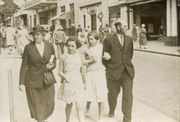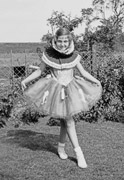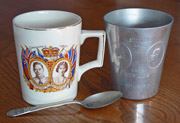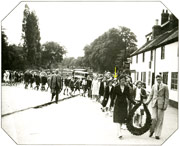One of my favourite places on a sunny day was 'The Brook' and the village children would spend hours there. This was Fairham Brook which is a stream feeding into the River Trent and it meanders from Clifton Lane in Wilford to Clifton Village and onwards. The water was fast flowing and very shallow so it was ideal for fishing for minnows which we caught with a piece of cotton suspended from a cork float. The fish would swallow the end of the cotton and we would net them. We would also catch them in a jam-jar baited with a bit of bread. I can still imagine I can feel the pebbles as we played barefoot in the stream, although sometimes when the water was very cold we wore wellington boots.
By crossing the Brook by a small brick bridge, or by stepping stones, the villagers could reach a grassy area with a well worn path which went all the way through Clifton Grove to the Clifton Estate. People of all ages found that this was a very good place to have picnics under the shade of the many pussy-willow trees which grew along the water's edge.
Unlike the Brook the River Trent was deep, wide and dangerous. On the main road in Wilford, on the other side from Wilford School, was a grassy bank called the Bee Bank which with its large trees helped to protect the village from flooding. However, this bank was not enough and almost every spring when heavy rain or melted snow from the Derbyshire hills combined with the tides coming up the river and the Trent would burst its banks. Dad had known of this danger when he bought our house in Wilford, but he made sure that even if the flood waters reached the level of the cellar floor there would still be at least 10ft before it reached our living quarters. When a flood was deep and Mum needed to buy food from the shops some young neighbours who had a raft were given a basket, a shopping list and money so that they could paddle to the shops and back.
In 1935 the country celebrated the Silver Jubilee of King George V and Queen Mary. On May 6th Wilford School closed for the day and all the pupils were lined up in the playground and a representative of the County Council presented each of us with a Bronze Medallion. On one side of it are the profiles of the King and Queen with the dates 1910 and 1935. On the other side of the medallion are the words "Nottinghamshire County Council Education Committee" and a shield enclosing illustrations of a tree, a printing press, a coal miner's pick, shovel and lamp, and in the fourth quarter a sheaf of corn. The quarters are separated by a wavy line representing the waters of the River Trent and in the very centre of the shield is a coronet. A red, white and blue ribbon enabled the medallion to be attached to the pupil's coat.
One of the directors of the school, I think it was Mr Bates, presented everyone with an aluminium beaker. It was embossed with profiles of the King and Queen and engraved with the words "Silver Jubilee 1910 1935 Wilford". This presentation was followed by a party on the playing field.
The Bicentenary of the School was celebrated in 1936 by a procession of pupils through the village to the Church. A laurel wreath was carried by the Head Girl and Head Boy, and was placed by the memorial to The Reverend Benjamin Carter who was the great benefactor and had endowed the school. After the service there was tea in the Parish Hall then back to the school for sports on the playing fields.
There was another royal occasion in 1937 when Wilford School celebrated the Coronation of King George VI and Queen Elizabeth. All the children of the village between the ages of five and fifteen gathered in the schoolyard and were presented with a 'Celebration Teaspoon'. The top of the spoon was decorated with a crown, a Tudor Rose and the words "1937 Coronation King George VI". Mr. Bates also gave us a white china mug decorated in gold with portraits of the King and Queen, an array of six flags and St. Edward's Crown. The mugs were then used to hold our drinks at the tea party that followed. By this date I was at West Bridgeford County Secondary School but I was pleased to be invited back for this occasion.
 |
| Mum, Margaret Lill, me and Dad in Blackpool, c1936. |
I travelled to the new school by bicycle in all weathers, and I would continue to do this for the rest of my school life. At Bridgeford I had to learn to mix with people from many walks of life, and from other countries. I was expected to do hockey, tennis, swimming, gymnastics, cooking, sewing, music, art, mathematics, geography, languages, reading and writing. During the first term I had a medical and I was told that I had a curved spine, but it was hoped that remedial exercises would benefit me. I was happy to do the exercises but it meant getting to school by 8.30am.
All the pupils were expected to wear school uniforms. The boys wore black trousers and black blazers with a school badge of black and gold on the breast pocket. The girls wore black gymslips over white blouses with a black and gold tie.
My new school was not as big as I would have expected. It was a drab Victorian building with a very small play area shared by the boys and girls. There was no sports ground so for tennis and hockey we had to cycle to Lady Bay Sports Ground which was about two miles away. We had to go a similar distance into Nottingham for swimming.
Unlike Wilford School I cannot remember enough to be able to describe this school in detail, but I can remember a large hall which served for both assembly and as a gymnasium. Off this hall were a number of rooms including a chemistry room and a biology room. Cooking, sewing and domestic science were taught in a small outbuilding.
There were many changes to come at school. A quite impressive new school was built on the Loughborough Road and we moved there in September 1937. Everything was new and even the school colours were changed so our black and gold uniforms were now royal blue and yellow. No longer did the girls wear a black beret with a gold tassel they now had a blue biretta
I enjoyed being in the new building and it was much better having cloakrooms, with one for wet clothes and wellingtons, which was a boon after cycling two miles in the rain or snow! There was a gymnasium with a shower room, and this was the first school I had attended which had indoor toilets! In the dinning room the long tables were laid with cutlery and with drinking water. Food was served from the school kitchen, but it was expensive and so I continued to take a packed lunch. The school was surrounded by fields and we had provision for rugby, hockey, tennis and athletics.



 Home
Home